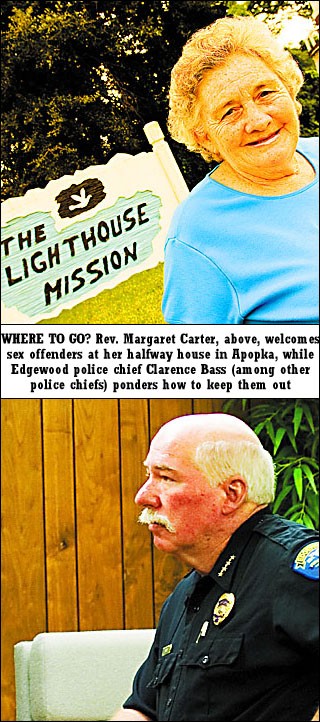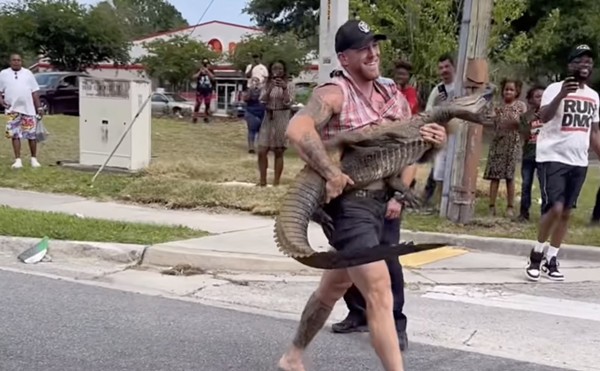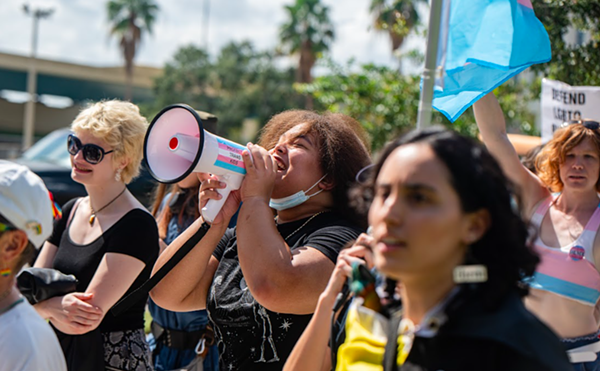Go buy an Orlando metro-area map. Pick the Rand McNally; it's fairly comprehensive and costs $5. Open the map and find Winter Park. Dig out your ruler and grab your kid's compass – the one with the little yellow pencil on one end and the point he menaces his classmates with on the other.
Whip out the calculator and divide 2,500 by 5,280, the number of feet in a mile. You'll get 0.47. Use the ruler and the map's scale to measure off a half-mile in distance. Now open up the compass.
Start drawing circles all over Winter Park with the pointy end resting on every school, park, playground or day care center listed on the map. Look for the little red buildings with the flags on top and the green spaces flecked with white specks.
You will quickly notice that there are precious few parts of Winter Park that aren't bound by at least one ring. If you drew your map carefully, the Winter Park portion of it now resembles the desk blotter of a sloppy coffee drinker – rings covering every inch.
This is why you cannot move to Winter Park if you have been convicted of any sort of sexual crime against a minor under the age of 16. On July 25, the city commission passed Ordinance 2638-05, which prohibits sexual offenders or predators from establishing a permanent or temporary residence within 2,500 feet of any park, school, school bus stop, day care center, or playground.
Winter Park's action follows a similar ordinance passed in the city of Oviedo in Seminole County on June 6. The cities of Apopka, Maitland, Belle Isle, Edgewood, Ocoee and Winter Garden are all investigating similar laws. According to the American Civil Liberties Union of Florida, roughly 40 cities in the state are now pursuing sex offender ordinances. Across the country, 14 states are working on similar laws.
The situation is similar to what America experienced in the early 1980s after Three Mile Island pushed nuclear power above the fold. People began protesting nuclear plants proposed in their neighborhoods, shouting, "Not in my backyard!"
But there is one self-evident difference between the NIMBY outcry generated by the amorphous threat of a leaking nuclear core and the current spate of ordinances that effectively ban sexual offenders and predators from moving into local neighborhoods: You can flip a switch and regulate the operation of a nuclear reactor. You can make laws that shut them down and make them go away.
It doesn't quite work that way when you try to shut out sex offenders. While you can pass laws restricting where they can live and travel, there is no concrete data to prove it does any good. "There is no research to suggest that residency restrictions increase public safety," says Dr. Jill Levenson, a professor of human services who researches sexual violence and criminal policy at Lynn University in Boca Raton, Fla. "Unfortunately, there is no one panacea – treating sexual offenders requires a collaborative approach between law enforcement, probation officers, treatment providers, family and the community," says Levenson, the author of two 2005 studies dealing with sex offender residence restrictions. "There is no magic bullet."
Florida's lawmakers and city officials think otherwise, and their reaction is not surprising given that the state has witnessed three well-publicized child abductions and murders since 2004. The killings of Jessica Lunsford and Sarah Michelle Lunde in March and April of this year garnered national media attention, and in February 2004, 11-year-old Carlie Brucia of Sarasota was abducted and murdered. Brucia's kidnapping from a car wash was captured on videotape that was broadcast by every news network in America.
GRANDSTANDING?
Every pending city ordinance takes its lead, and often its wording, from the law passed by the city of Miami Beach, whose mayor, David Dermer, has led the push to expand sexual offender and predator limits to 2,500 feet, up from the state-mandated distance of 1,000 feet. Dermer began lobbying for the new limits shortly after the murders of 9-year-old Lunsford in March and 13-year-old Lunde in April.
Florida laws already provided for 1,000-foot residence limits from specified locations for sexual offenders and predators, but Dermer and his staff noticed that state laws specify 2,500-foot zones of exclusion around selected adult entertainment venues. After an adult-products trade show was blocked from coming to the city because of the 2,500-foot buffer zone rule, Miami Beach began exploring the idea of expanding the existing 1,000-foot ban to include the extra 1,500 feet mandated by the adult entertainment statutes.
After learning about Dermer's plans, Hamilton Township in New Jersey passed the nation's first 2,500-foot limit for sex offenders and predators on May 17. Hamilton Township was the home of Megan Kanka, the 7-year-old whose rape and murder in 1994 prompted the New Jersey sex offender registration law that bears her name. On May 18, the town of Davie, 20 miles north of Miami Beach, became the first city in Florida to up its limits by enacting its own 2,500-foot ordinance. Miami Beach ratified Dermer's proposal on June 8.
On May 9, the state ratified the Jessica Lunsford Act, a law that requires minimum prison sentences of 25 years for sex offenders who commit offenses against children under 12; the act also mandates Global Positioning System (GPS) tracking devices for these offenders and offenders who violate probation.
On the national front, the U.S. Senate voted unanimously Aug. 2 to create a national sex offender registry, and the bill would also require states and cities to enact measures to better monitor the sex offenders living in their communities. Bill sponsor Sen. Byron Dorgan, a North Dakota Democrat, was quoted as saying that Martha Stewart received more surveillance by law enforcement than most sex offenders. Dorgan named the bill "Dru's Law," after Dru Sjodin, a 22-year-old Grand Forks, N.D., woman abducted and murdered in November 2003. "Dru's Law" still faces approval by the House of Representatives before going to the president to be signed into law.
A second bill, House Resolution 1505 – basically a federal version of Florida's Jessica Lunsford Act – was introduced April 6 by Republican Congresswoman Ginny Brown-Waite of Florida's 5th District.
"What's fueling all this is grandstanding by politicians," says Randall Marshall, the legal director for the American Civil Liberties Union of Florida. "These laws do nothing for public safety and give the public a false sense of security. There is little doubt that the only way these laws will be stopped is through some sort of legal determination."
The latest law to affect Florida's sex offenders? An Aug. 6 measure by the Florida Department of Law Enforcement now prevents sex offenders who are being tracked for crimes against children from being allowed into public hurricane shelters. Where can these offenders seek refuge during a storm? Prisons, according to Robby Cunningham, a spokesman for the state's Department of Corrections.
UNINTENDED CONSEQUENCES
While Marshall and the ACLU consider challenging the constitutionality of the recent spate of city ordinances in Florida, the Iowa State Supreme Court reversed a lower court's ruling on July 29 and upheld that state's broad residency restrictions on where its sex offenders can and cannot live.
In its ruling on the appeal, the court wrote, "We conclude Seering `Keith Frederick Seering, the sex offender in question` has suffered no deprivation of his federal or state constitutional rights related to substantive and procedural due process, ex post facto laws, self-incrimination, or cruel and unusual punishment. We also observe that the United States Eighth Circuit Court of Appeals recently rejected similar challenges."
What disturbs Marshall is the "domino effect" of city after city either enacting the same boilerplate ordinance or attempting to one-up its neighbors with harsher provisions.
"We're looking at each of these laws – there are some 40 cities doing this throughout Central and South Florida – and each community seems to be trying to outdo the other. Or if one `city` does it, then the one next door feels it has to enact a similar law to prevent sex offenders from moving to `their` city. It's become kind of an irrational hysteria," says Marshall, who has been practicing law for more than 20 years.
For an example, look no further than Ocala. In April, convicted sex offender Clovis Ivan Claxton, 38, apparently committed suicide after laminated signs were posted in his neighborhood bearing his picture, his personal data and the words "CHILD RAPIST" in bold black letters. His crime? He was convicted 14 years earlier in Washington State of exposing himself to a 9-year-old girl. The FDLE website stated that Claxton had been charged with raping a child, though he had not been.
The reason for his behavior, Claxton's parents said, is that a debilitating bout of viral meningitis at age 10 left their son with the mental capacity of a young child. In the last years of his life, Claxton had to use leg braces and was frequently confined to a wheelchair.
Just before Claxton killed himself, Marion County Commissioner Randy Harris introduced a proposal to place metal signs in neighborhoods where sex offenders live. Two months after Claxton died, Harris came up with the idea of banishing offenders to Mexico.
Or consider the case of Orlando's own Rayon "Junior" Payne. After spending more than two years in prison for sexual battery, among other charges, Payne – better known as NSX from his days behind the microphone at Orlando's 95 Live pirate radio station – is now a free man. All of his convictions were overturned. But he can't seem to shake being identified as a sexual predator on the FDLE website, even though he shouldn't even be listed there anymore. The bureaucracy screwed up, and it's Payne who has to live with it.
"The sex case is gone, overturned," says Payne, now 30. "But then my mom's sitting at home, and she gets this call from the neighbors who say there's a sexual predator living in her house. They want to picket the house. I call my lawyer, we fax the paperwork to get it removed from the website, and even the `FDLE` operator says he doesn't know why I'm still on `the web page`."
Payne plans to move away from Orlando and put the past behind him. "You don't realize the reach of the law until it affects you, your father, your brother, your mother," he says. "You don't care about it until you yourself are in the situation."
MUGS ON DEMAND
The Internet is the easiest way to glimpse the (mostly) men the public seems to be deathly afraid of: On the FDLE's sexual offender and predator website, http://www3.fdle.state.fl.us/sopu/index.asp, you can look at the pictures of the offenders and predators in your city or ZIP code. You can read their truncated rap sheets as the mug shots scroll by, a never-ending parade of glazed stares.
As of May 5, 2005, the 50 states listed 549,038 registered sex offenders living in America, according to the National Center for Missing and Exploited Children; the center also estimates that an additional 100,000 offenders and predators are "lost" to the criminal justice system because of noncompliance with registry requirements. Florida ranks third in the total number of sex offenders in residence – 34,531 – behind Texas and California.
That may sound like a lot, but the numbers aren't rising.
"We have not seen any major spikes in the uniform crime report numbers for sex offenses in the last few years," says FDLE spokeswoman Kristen Perezluha. "But with so many cases in Florida recently, we are seeing more attention. The media is definitely paying more attention to the issue."
The media coverage has managed to overlook a very telling statistic: According to the NCMEC, only about 100 child abductions in any given year – less than a fraction of 1 percent of all cases – result in child murders, and those deaths account for less than one-half of 1 percent of all the murders committed nationwide.
"The truth is that child murders are a rare event," says Levenson, the Lynn University sexual violence researcher whose two 2005 papers found no connection between recidivism and the proximity of sexual offenders' residences to schools and other places where children congregate.
But those are the cases that spur lawmakers to tighten the noose for people convicted of sex crimes. Registry laws place a 20-year-old first offender who had consensual sexual relations with a 15-year-old – unwittingly committing statutory rape – on the same list as John Couey, the 46-year-old Homosassa man who confessed to kidnapping and murdering Jessica Lunsford, notes Levenson.
"Problems come when you pass legislation and enact strategies that are just not proven to work or that have unintended consequences," Levenson says. "Obviously, the 20-year-old is not the guy we're worried about, and now he's going to have to deal with the legal consequences of his offense for the rest of his life."
Couey was registered in Citrus County as a sex offender, not a predator. In Florida, residency restrictions and registration procedures only apply to a person who has committed a listed sex offense, regardless of the date the offense was committed, and who is either currently in custody or was released on or after Oct. 1, 1997, the date that current regulations took effect. There are many listed sex offenses, but the most common are lewd and lascivious conduct – such as flashing or making a sexual proposition – and sexual battery – physically touching another person in a sexual manner. Sex offenses can be committed against minors or adults; the FDLE site generally specifies whether or not the crimes involved minors.
A sexual predator designation requires a written court finding, and the person must have committed either one first-degree felony sex crime, or two second-degree felony sex crimes. The predator designation only applies to crimes committed on or after Oct. 1, 1993. Since the current registry law was not retroactive, persons who were released prior to October 1997 are not required to register as offenders or predators and are not subject to any residency restrictions.
Ironically, laws that keep offenders out of cities may actually exacerbate their problems. "When these offenders are forced out into rural areas, they have no access to mental health facilities, they are separated from their families and support networks, and they become harder to track," Levenson says. "One-size-fits-all policies are simply not the most effective."
Cops, on the other hand, deal with people on the other side of the issue. They know that the scientific weight of all the studies concerning sex offenders and predators will not provide an ounce of comfort to a parent whose child is molested or murdered.
Apopka police chief Chuck Vavrek is considering putting photos of sex offenders' houses on his department's website so parents can warn their children. "We want parents to be able to point these houses out to their kids and say, 'Don't go near it.' We've received many more thank-yous for pursuing this than opposition – more are for this than against."
Vavrek says Apopka has 22 registered sex offenders living in its boundaries. "The first priority is the safety of our kids."
Other chiefs echo Vavrek's concerns. "We feel that we've got to cover the loophole," says police chief Clarence L. Bass of Edgewood. "If we don't pass our own ordinance, then we're going to have sex offenders moving into Edgewood. I sometimes feel empathy for them, but then I open up the newspaper and see another child kidnapped," he says, referring to Aug. 1 reports of an 8-year-old Nevada girl who was found in Mexico after being abducted by a convicted sex offender on July 22.
THE LAST STOP
If nobody wants a sex offender living nearby, where do they go?
Less than a quarter-mile from the Orange and Seminole county line sits The Lighthouse Mission of Orlando, a halfway house that accepts sex offenders as residents and has established itself as a refuge from the societal stigma that plagues ex-convicts.
Run by the Reverend Margaret M. Carter, the yellow buildings exist in a largely industrial neighborhood in an unincorporated area of Orange County not subject to city ordinances. A 4-foot-tall model of a lighthouse adorns the front yard, and a mural composed of a picture of Christ, a second lighthouse and the Bible verse "I am the light of the world" covers an entire wall.
Carter turned 71 in May and has run the mission for 20 years from its present location. She sits behind a cluttered desk in a crowded office – a twin bed blocks the path to a shelf of videocassettes. A call came in from a man who had just been released and needed a place to sleep, she says, "and I haven't had time to move the bed out yet."
Her phone rings twice during the interview, and she says she awakens at 4:30 a.m. daily – "except Saturday" – to begin cooking for her 24 residents and making the rounds for donations from local fast-food restaurants and Costco. The offerings are usually buffet leftovers and unclaimed pizzas. About a third of her current group is sex offenders; she doesn't take predators.
"I think the reason so many of them reoffend and go back `to prison` is that society makes it so hard for them," she says. "They can't get jobs. They can't get a place to live. In this day and age, as soon as somebody hollers 'sex charge,' you're guilty before you've even had a chance to defend yourself."
Most of her residents, all men, end up staying between two and three years, paying roughly $100 a week for room and board. "In three years' time, they generally have a vehicle, money for an apartment and a place to go," she says. "Most have been turned loose from their families and have no contact, though we try to press on them to get back into contact."
Her sex offenders must attend church services three times a week. The county mandates counseling sessions once a week, and offenders must check in with parole officers once a month. Nobody causes any major problems. "Most of them realize they've made a mistake and that they've paid for it," she said. "Most are trying to better themselves. But it's hard when the world's against you."



















